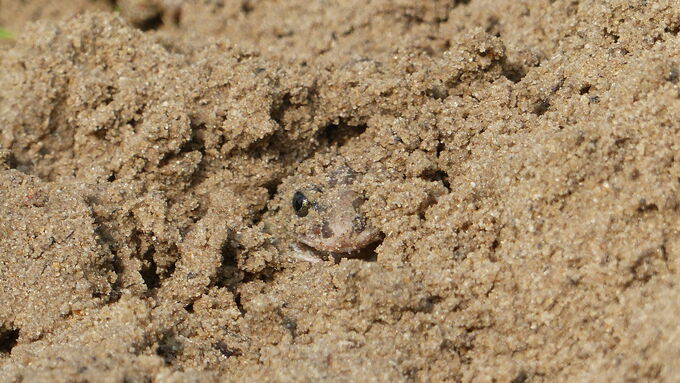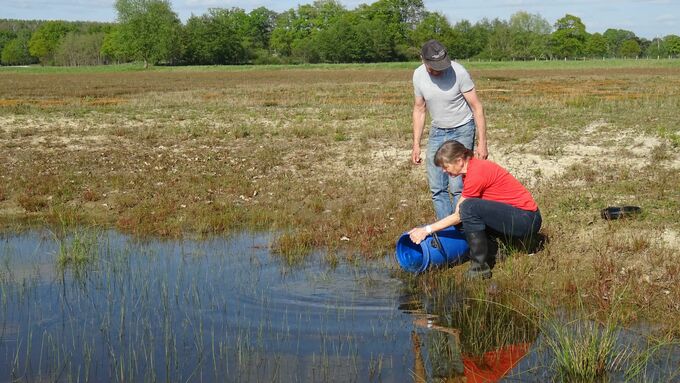Due to their hidden way of living, common spadefoots are very difficult to find. This young toad is just about to burrow into the sand after being released. © Dr. Martina Raffel, Bezirksregierung Münster
download picturemain content
Project of the month
#7/2022 SUCCESS CONTROL
Monitoring of repatriation of the common spadefoot (Pelobates fuscus)
The common spadefoot is classified as ‘critically endangered’ in North Rhine-Westphalia. As part of the action ‘Conservation breeding for the spadefoot toad’ (Action A2), in the first two project phases of the LIFE IP Atlantic Region DE common spadefoots (Pelobates fuscus) were bred in the breeding station in Enniger in the district of Warendorf and (re)introduced in suitable areas within the original distribution area. Between 2017 and 2021, more than 40,000 common spadefoots were released – usually as tadpoles, but sometimes also as already metamorphosed young toads. ‘NABU Naturschutzstation Münsterland’ coordinated the breeding and (re)introduction of the toads. Monitoring is carried out in cooperation with the respective local partners, mainly biological stations.
The common spadefoot is one of the most difficult amphibian species to record due to its secretive and hidden lifestyle. Because of its endangered status, it is monitored in a total census in NRW, i.e. all known occurrences of the species are recorded by the State Agency for Nature, Environment and Consumer Protection NRW (LANUV) in cooperation with the biological stations. New populations are included in the regular census.
In principle, two different methods are used within LIFE IP to monitor the spadefoot population: On the one hand, the animals are recorded in detail by using amphibian fences. These are erected during the migration period of the toads. The fences are made of a commercially available soft material, are about 50 centimetres high and are buried a few centimetres into the ground. Buckets are buried at ground level at regular intervals along the fence to collect arriving amphibians. The animals bump into the fence during their migration and fall into the buckets sooner or later when looking for a possible gap. The buckets are checked daily and all amphibians inside are documented, counted and released.
A second method is to survey calling males with special technical devices called hydrophones (underwater microphones). With their help, the very quiet mating calls can be recorded under water. If the microphones are combined with MP3 players as recording devices, these ‘listening boxes’ can also collect data over longer periods of time and then be analysed. However, male common spadefoots only call during a very short period of the year (two to four weeks) and only when weather conditions are favourable. If it is too dry or cold, the animals break off the migration and do not reproduce until the following year. Since it is not known whether all or how many of the males which are ready to spawn call, the results of this method are not quite as reliable for estimating the population size. It rather allows a general detection of the species in waterbodies or a rough estimation of the number of calling males, but nevertheless it represents a rather time- and cost-efficient detection method of this elusive species. In addition to the two methods, adults and spawn can be searched for in the respective reproductive waters and larvae of the species can be detected by means of scoop nets or fish traps.
Monitoring started after the first releases within the framework of the LIFE IP; comprehensive monitoring of all areas and actions started in 2021. Currently, first monitoring reports from three areas are available.
Rieselfelder Windel, Bielefeld (action C20)
In the nature reserve ‘Rieselfelder Windel’ in Bielefeld, the eastern part of an existing waterbody which was drying up early each year, was deepened and desludged in 2016 as was the western part in 2018. In the middle section, part of the excavated material was filled in, creating two separate waterbodies. In February 2018, another small pond was created within the framework of the LIFE IP so that it would permanently hold water. A total of 11,950 larvae and 750 metamorphosed juveniles were released into five optimised or newly created small ponds between 2014 and 2019, of which 9,350 larvae and 500 juvenile toads were released as part of the LIFE IP Atlantic Region DE.
In 2021, the common spadefoot was detected in four of the five study ponds in this area. In the newly created small pond, on one study day the highest number was documented with at least ten callers. The observation of larvae in very different age and development stages suggests several spawning phases. In spring 2020 and 2021, four migrating adults were recorded using the wildlife crossing between the nature reserves ‘Rieselfelder Windel’ and ‘Kampeters Kolk’ on the opposite side of the motorway.
Langenbergteich, Paderborn (action C11)
From 2018 to 2020, around 6,200 tadpoles and 300 metamorphosed juvenile toads had been released in the nature reserve ‘Langenbergteich’ and nearby water bodies as part of the LIFE IP. First monitoring was then carried out in spring 2019 by the Biological Station Kreis Paderborn - Senne. Two amphibian fences were erected: The pond Langenbergteich and the new blink to the south of it were fenced off near the edge to catch migrating amphibians. The high groundwater level due to rainfall made the survey difficult, as many buckets could not be installed or had to be removed again. 45 toads were detected at the pond and seven at the new blink. A search for spawn or tadpoles was unsuccessful.
Lippe floodplain, district of Soest (actions C15, C16, C108)
A particular focus of the reintroduction of the common spadefoot is the Lippe floodplain in the district of Soest. Current records were only given directly below Lippstadt (Rote Beeke) and on the edge of the Lippe floodplain terrace near Lippstadt-Eickelborn. With the creation of 15 additional spawning grounds, the optimisation of adjacent terrestrial habitats and the subsequent release of individuals from the breeding station in Enniger, the conditions were created to improve the conservation status of the species in the Lippe floodplain and to establish further populations. In total, around 16,000 individuals were released in nine areas of the Lippe floodplain in the district of Soest and in the immediately neighbouring district of Warendorf from 2016 to 2020. A first monitoring for amphibian species was carried out by the Biological Station Soest in 2021 between Lippstadt and Lippetal. Five waterbodies along the Lippe as well as the original population ‘Rote Beeke’ were examined by means of amphibian fences.
A total of 101 common spadefoots fell into the buckets during the 42-day study period, 15 of them from the original population at ‘Rote Beeke’. Thus, 86 toads can be attributed to the releases from 2017 to 2019. All waterbodies which had been provided with offspring from the breeding station have been accepted. The species' previous range in the district of Soest was successfully extended westwards by 22 kilometres along the Lippe floodplain. The crested newt (Triturus cristatus) was found in all areas surveyed as well. In addition, the tree frog (Hyla arborea) was recorded in the ‘Disselmersch’.
Related topics
- Species profile 1197 – common spadefoot
- Action A2: Conservation breeding of the common spadefoot
- Project of the month January 2018: Saving the “Potato Toad”
- Short film about the reintroduction oft he common spadefoot along the river Lippe (in German) (mp4, 73.2 MB) (link opens in a new window)





